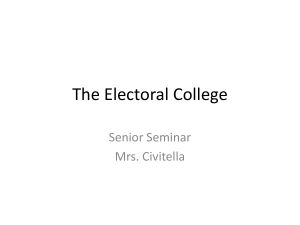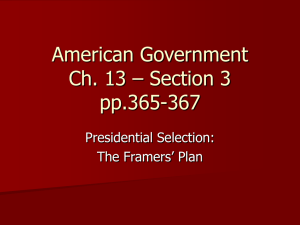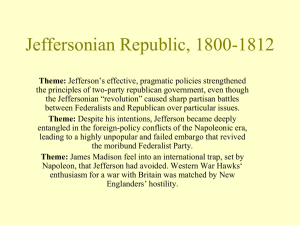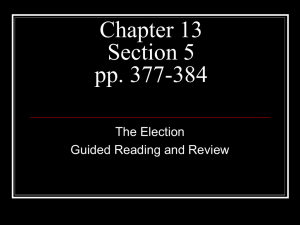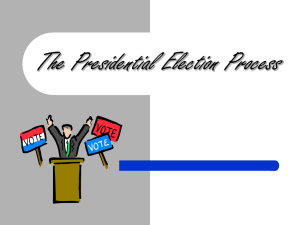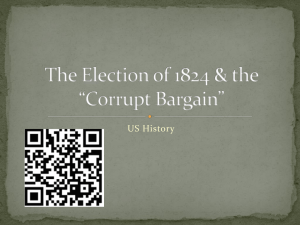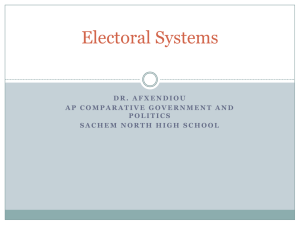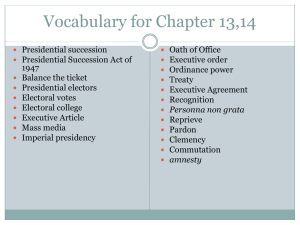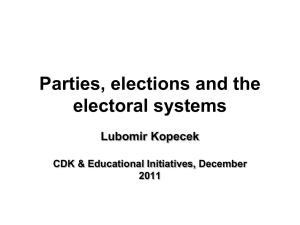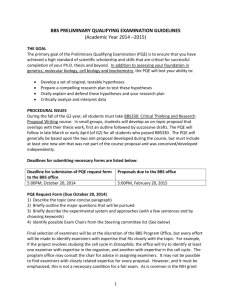Electoral College
advertisement
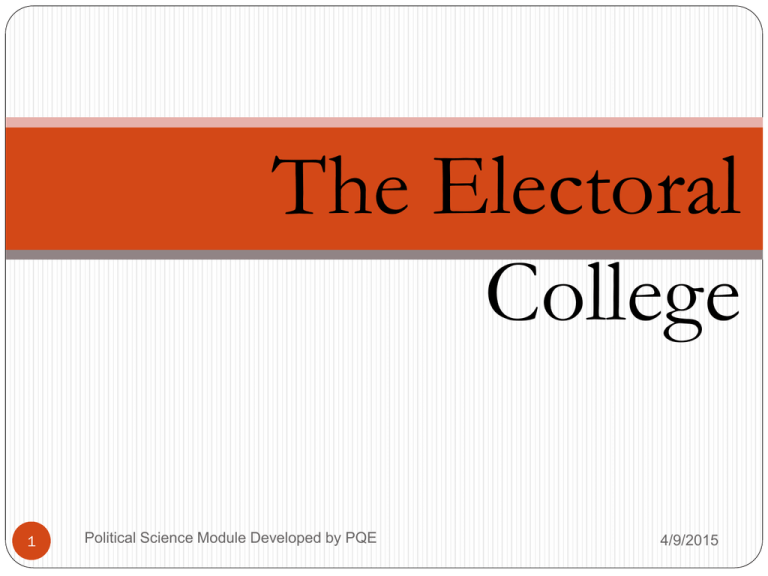
The Electoral College 1 Political Science Module Developed by PQE 4/9/2015 True or False? The candidate with the most votes is elected president. Answer: Not necessarily. Ask Al Gore. 2 Political Science Module Developed by PQE 4/9/2015 The 2000 Election The Popular Vote Al Gore George W. Bush 50,996,039 50,456,141 The Electoral Vote George W. Bush Al Gore 3 Political Science Module Developed by PQE 271 267 4/9/2015 Historical Background The framers of the Constitution disagreed on how to elect a president Congressional selection direct popular election. The electoral college was a compromise combining features of both approaches. 4 Political Science Module Developed by PQE 4/9/2015 The Electoral College and Federalism The electoral college also reflects the federal nature of the Constitution Ensures that the states have a role in selecting the president. 5 Political Science Module Developed by PQE 4/9/2015 State Electoral Votes Each state is entitled to as many electoral votes as the sum of its representation U.S. House of Representatives U.S. House of Senate Ohio: 18 House members plus 2 senators = 20 electoral votes Total: 6 435 House members 100 senators 3 electors for the District of Columbia = 538 electoral votes Political Science Module Developed by PQE 4/9/2015 Who are the Electors? Individuals selected in each state to officially cast that state’s electoral votes. Ohio selects 20 electors to cast the state’s 20 electoral votes. Framers anticipated that electors would be state leaders who would exercise good judgment. Today, party leaders select electors who are typically long-time party activists. Electors almost always vote for their party’s candidates. 7 Political Science Module Developed by PQE 4/9/2015 Delegate Votes Divided Each state determines the manner of selection All but two states use a winner-take-all delegates statewide election system Nebraska Maine Everyone else If Candidate A gets the most votes in a state, Candidate A gets the all of the delegates. 8 Political Science Module Developed by PQE 4/9/2015 Voters and Electors Therefore, An Ohioan who votes for Obama is really voting for a elector pledged to cast the state’s electoral votes for Obama. Remember: In 2000, Bush won all of Florida’s 25 electoral votes because the final official vote tally showed him ahead of Gore by about 600 votes. 9 Political Science Module Developed by PQE 4/9/2015 The Real Election In December of election year The electors gather in their respective state capitols to cast ballots for president and vice president. In January Congress comes into session They open the ballots received from each state They announce the official outcome. 10 Political Science Module Developed by PQE 4/9/2015 What if no one receives a majority? To win, a candidate needs a majority, 270 electoral votes. If no candidate has a majority the House of Representatives selects the president from among the three presidential candidates with the most electoral votes. If this happens, each state has one vote. Happened only once! 1824 Congress chose John Quincy Adams over Andrew Jackson and Henry Clay. The Senate selects the vice president from the top two vice- presidential candidates. 11 4/9/2015 Popular Vote v. the Electoral Vote In a close race, the popular vote winner may not win the electoral college. One candidate may win states by lopsided margins while the other wins states by narrow margins. Electoral vote winners who lost the popular vote Bush over Gore in 2000 Benjamin Harrison over Grover Cleveland in 1888 Rutherford B. Hayes over Samuel Tilden in 1876 12 Political Science Module Developed by PQE 4/9/2015 Criticisms of the Electoral College The popular vote winner may lose the presidency. Electors may vote for persons other than their party’s presidential and vice presidential candidates. If no candidate receives a majority, Congress will pick the president and vice president. 13 Political Science Module Developed by PQE 4/9/2015 Proposals for Reform Eliminate electors but still count electoral votes. Choose the president by direct popular election. 14 Political Science Module Developed by PQE 4/9/2015 Review Question North Carolina has 13 U.S. representatives. How many electoral votes does the state have? 15 Political Science Module Developed by PQE 4/9/2015 Review Question Who are electors? 16 Political Science Module Developed by PQE 4/9/2015 Answer They are individuals selected in each state to officially cast that state’s electoral votes. Electors are typically long-time party activists who are selected by their state party organization as a reward for their loyalty to the party. In most states, electors are officially pledged to support their party’s presidential and vice presidential candidates. 17 Political Science Module Developed by PQE 4/9/2015 Review Question Does it matter whether a candidate carries a state by a few votes or a lot of votes? 18 Political Science Module Developed by PQE 4/9/2015 Answer No. A candidate receives all of a state’s electoral votes whether the candidate carries the state by one vote or a million votes. In every state except Nebraska and Maine, the race is winner take all. 19 Political Science Module Developed by PQE 4/9/2015 Review Question What is the small state bias? 20 Political Science Module Developed by PQE 4/9/2015 Answer The electoral college has a small state bias because every state gets at least three electoral votes regardless of its population. As a result, small states such as Alaska, Wyoming, and South Dakota enjoy a greater percentage of electoral votes than they would merit based strictly on population. 21 Political Science Module Developed by PQE 4/9/2015

